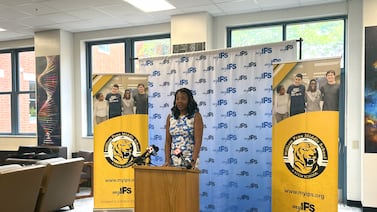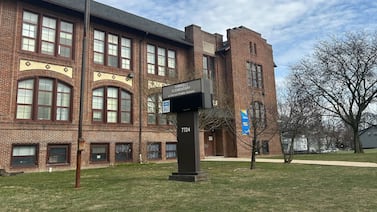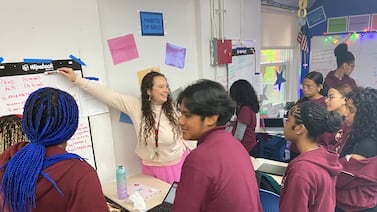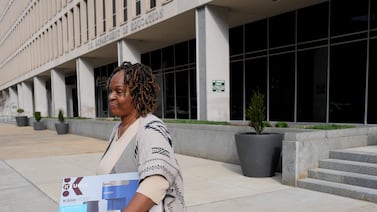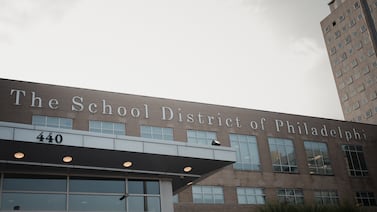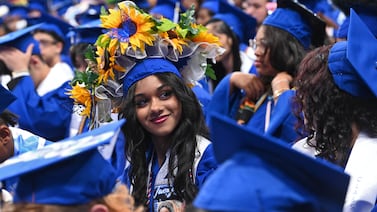Sign up for Chalkbeat New York’s free daily newsletter to keep up with NYC’s public schools.
Teachers and students across New York City were shut out of their virtual classes Tuesday morning, a major glitch as city officials ordered schools to offer remote instruction because of the snowstorm.
The tech problems prevented many — though not all — teachers and students from logging into Zoom, Google Classroom, school email accounts, and even attendance tracking tools.
City officials largely blamed the technical snafu on IBM, which helps manage the login process for the city’s remote learning platforms. During a midday press conference, Chancellor David Banks said IBM was not prepared for the crush of users logging in at once but problems were being ironed out.
More than one million students and staff had successfully signed on, officials said. Still, student attendance fell to 78% down from 87% on Monday, according to preliminary data that does not yet include all schools.
“To say that I am disappointed, frustrated, and angry is an understatement,” Banks said, adding the department would conduct a “full analysis” of what went wrong. “This was a test. I don’t think that we passed this test.”
Tuesday represented the first time the entire school system was expected to go virtual during a snowstorm — a major test of the city’s strategy to switch to remote learning instead of canceling classes due to inclement weather. To give schools and families time to prepare, officials announced nearly a full day in advance their plans to close school buildings. Banks vowed teachers would be ready to deliver live lessons that mirror a traditional school day.
But as students and teachers tried to log on Tuesday morning, many encountered an error message that displayed a digital image of a lone teacher standing on a podium. On some campuses, tech problems derailed much of the morning’s lessons. Other schools didn’t seem to be affected, making the scale of the outage unclear. An IBM spokesperson said Tuesday afternoon the issues had been “largely resolved” and “we regret the inconvenience to students and parents across the city.”
Some parents and educators said the technical difficulties reminded them of the early days of the pandemic. The damage could reverberate, some worry.
One Manhattan elementary school leader who had to cancel morning classes because of the tech problems, said, “The bigger impact is … the intangible piece: the trust, the perception of competence, which was a major issue during COVID.”
Adam Schwartz, a teacher at Franklin Delano Roosevelt High School in Brooklyn, said his second grade daughter’s morning class was disrupted, though she was able to successfully login around 9 a.m.
Schwartz, who teaches English to students who are new to the country, said he was dreading remote instruction on Tuesday, as his students often shy away from participating during in-person classes. But they seemed more comfortable in the virtual environment, regularly chiming in with emojis. His classes weren’t affected by the outage because they started later in the day.
“It was kind of a slight remove from the normal social pressures of school that make it so difficult for kids to communicate,” Schwartz said. “And it allowed me to be a little silly.” Due to back problems, he logged into his classes sprawled on his belly on his kitchen floor. Still, only about half of his students showed up.
Remote learning practice runs didn’t help
City officials had previously conducted practice runs with students and families so the system would be prepared in the event of a remote snow day. But Michael Mulgrew, head of the city’s teachers union, said only smaller groups of students and teachers logged on at once.
“When we did the citywide test in October, we assumed it was a stress test. It turns out that’s not what the DOE did,” he said in an interview.
Some schools weathered the glitches better than others because they’ve held onto their school-specific websites and email accounts despite the Education Department asking them to do otherwise. Because of security concerns, the Education Department has been pushing schools to move to a centrally run domain, which no longer lets schools control the login process. But that central login system failed on Tuesday.
”If we still ran everything through our Gmail, today would have been fine,” one high school principal said.
Despite Banks’ assurance that schools would be ready to offer plenty of live teaching, some students and educators said there was less than usual.
Christian Rojas Linares, a senior at Manhattan’s University Neighborhood High School, said his teachers posted assignments online and, with a couple exceptions, were on hand to help students work through them. But some of his classes felt more like office hours than typical periods of instruction, and in certain cases there were just a handful of students in attendance, he said.
“When it comes to remote learning, you often tend to not get stuff done for the most part,” Rojas Linares said.
Still, he appreciated that the remote atmosphere was less stressful than a regular school day and noted his AP environmental science teacher used class time to help prepare for a test scheduled for Wednesday. “Even though it didn’t feel like a real class, I was still able to get work done,” he said.
Matthew Willie, the school’s principal, said his teachers were well prepared to switch to remote learning and did not contend with major glitches. Willie said he dropped into 15 to 20 virtual classrooms throughout the day and “there was good attendance and direct instruction taking place,” he said.
Willie said Rojas Linares’ experience may be unusual because he’s enrolled in a slew of advanced classes that tend to enroll a smaller number of students. “I really think the day went well for us,” he said.
Decisions about whether to call a snow day are typically contentious and come with tradeoffs, as many families rely on school for meals and may struggle to line up child care. Though some called on the city to cancel classes entirely, there is little room in the school calendar thanks to a growing number of holidays and a state requirement to hold 180 school days.
By afternoon, Brooklyn’s Prospect Park was a mix of slush and snow. Some parents expressed disappointment at the paltry amount of powder covering the ground, but kids were making the most of it, sledding down any hill they could find, sometimes wearing down the snow enough to see patches of mud and grass sticking out.
After an hour of online school, Christine Joyce, mom of a second grader and kindergartener at P.S. 321, made the executive decision to take her kids to the park.
“Zoom this morning was a little rough,” she said, noting that her kids were ultimately able to access their virtual classrooms, but she called it quits shortly after for a real snow day because she wanted her kids to experience some joy in the snow. They spent several hours building snowmen and forts, having snowball fights and sledding.
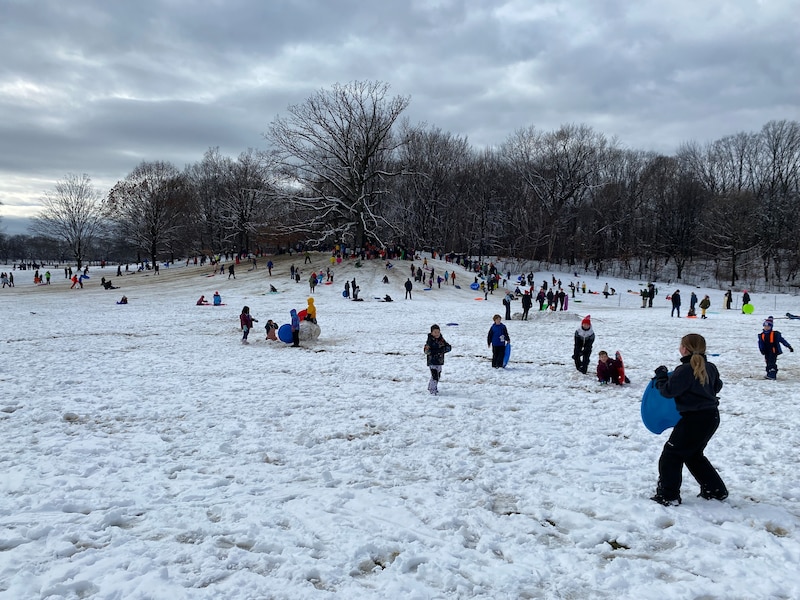
Abby Loomis, a fourth grade teacher at P.S. 414 in Brooklyn, said she appreciated the city’s early decision to pivot to remote instruction.
The vast majority of her students were able to log in, but challenges remained. During a math lesson, her students struggled to input fractions on their keyboards. Some children filled the virtual chat room with messages about wanting to play outside in the snow. And she opted to avoid continuing a social studies unit on slavery, a topic that felt too difficult to discuss in an online format.
Instead, she leaned more heavily on work students could complete on their own, such as editing biographies they’re writing about figures including Taylor Swift and Simone Biles. She devised a fun snow day checklist, including finding hot chocolate and throwing a snowball.
“It should just not be a rigorous rigid day,” Loomis said.
On Tuesday afternoon, the Education Department announced this week’s experiment with remote learning will be brief. Traditional in-person classes will resume Wednesday.
Michael Elsen-Rooney contributed to this story.
Alex Zimmerman is a reporter for Chalkbeat New York, covering NYC public schools. Contact Alex at azimmerman@chalkbeat.org.
Amy Zimmer is the bureau chief for Chalkbeat New York. Contact Amy at azimmer@chalkbeat.org.


